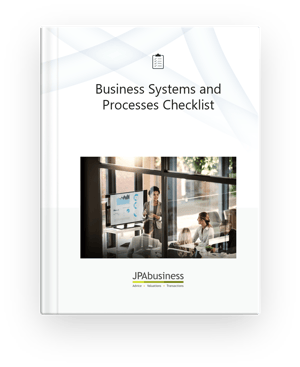There are several foundational systems required by most businesses to operate effectively.
In our ebook, Business Systems and Processes, we focused on six key business systems and their related processes and procedures, and examined how they contribute to a business model’s success.
As part of the ebook we created a checklist to help business owners and managers review the strength of these six core systems and related processes in your own businesses, and identify gaps and issues impacting your business performance.
Rather than ‘eating the entire elephant at once’, it’s easier to break down each element and develop an understanding of the strengths and weaknesses of what you currently have in place.
Then you can decide on refinements and enhancements to processes (e.g. introducing a new process to improve results, or perhaps a technology solution for automating a particular process).
Benefits of effective systems and processes
Having a set of effective systems and processes within a business can provide multiple benefits, including – but not limited to – the following:
Consistency
Consistent service, despite the product or service sold, is a core attribute in a business satisfying customer expectations.
Having systems and processes that enable consistent delivery to determined standards can have substantial benefits, including positive customer feedback and increased patronage.
Scale
Ensuring business activities are not solely reliant on individuals, but rather on standardised and automated processes, provides the opportunity for business activity and sales to increase over the same cost base, driving scale benefit which should enhance earnings – a scale advantage.
Efficiency
Well-established systems and processes, along with technology and automation, can have substantial efficiency benefits. They enhance the capabilities of management and employees, removing the need for time and labour-intensive manual tasks.
With more time available, management and employees can focus on crucial strategies that will help the business advance and expand.
Problem solving
Systems and processes, leveraging technology and monitoring performance data, can provide valuable and (often) real-time information on business delivery problems (e.g. shipment times, inventory levels, order status, equipment failure, customer experience), enabling rapid action on remedies to maintain run-rate and business operations. Savings on downtime can be significant.
Control
Well-functioning systems and processes offer the owner peace of mind that everything is going as planned/strategised.
Rather than keeping an eye on every business activity, focusing on systems and processes is a better way to keep business operations under control.
Business value
With a standardised method of operation underpinned by well-established systems and processes, no longer is a business reliant on key employees or owners for operational aspects that deliver the business’s value proposition.
Invariably this enhances the sustainability of earnings and is often an attractive business characteristic in the eyes of potential investors.
JPAbusiness offers a range of business valuation and advisory services. If you would like to discuss strategies to help you grow the value of your business, contact the team on 02 6360 0360 or 02 9893 1803 for a confidential, obligation-free discussion.

